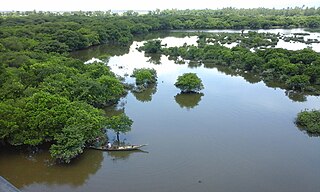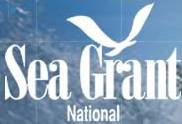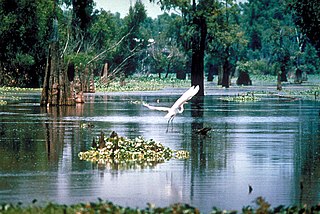This article needs additional citations for verification .(January 2018) (Learn how and when to remove this template message) |
| Formation | 1972 |
|---|---|
| Type | Federal Government |
Region | 34 states and territories |
Main organ | NOAA |
Parent organization | NOAA Office for Coastal Management |
Budget | FY 2016 |
The National Coastal Zone Management Program is a program of the US government that works with states and territories to protect, restore, and responsibly develop coastal communities, resources, and economies. The program is housed within the National Oceanic and Atmospheric Administration (NOAA) Office for Coastal Management. NOAA is an agency within the Department of Commerce. Participation is voluntary and 34 states and territories participate. States and territories agree to develop state programs that uphold the requirements specified in the founding legislation, the Coastal Zone Management Act of 1972.

The National Oceanic and Atmospheric Administration is an American scientific agency within the United States Department of Commerce that focuses on the conditions of the oceans, major waterways, and the atmosphere.

In the United States, the Department of Commerce is an executive department of the federal government concerned with promoting economic growth. Among its tasks are gathering economic and demographic data for business and government decision-making, and helping to set industrial standards. This organization's main purpose is to create jobs, promote economic growth, encourage sustainable development and block harmful trade practices of other nations. The Department of Commerce headquarters is the Herbert C. Hoover Building in Washington, D.C. Wilbur Ross is the current Commerce secretary.

The Coastal Zone Management Act of 1972 is an Act of Congress passed in 1972 to encourage coastal states to develop and implement coastal zone management plans (CZMPs). This act was established as a United States National policy to preserve, protect, develop, and where possible, restore or enhance, the resources of the Nation's coastal zone for this and succeeding generations.
Contents
Every five years, participants review their programs in one or more of the following areas: wetlands, coastal hazards, public access, marine debris, aquaculture, cumulative and secondary impacts of development, special area management plans, ocean and Great Lakes resources, and energy and government facility siting. [1]

A wetland is a distinct ecosystem that is flooded by water, either permanently or seasonally, where oxygen-free processes prevail. The primary factor that distinguishes wetlands from other land forms or water bodies is the characteristic vegetation of aquatic plants, adapted to the unique hydric soil. Wetlands play a number of functions, including water purification, water storage, processing of carbon and other nutrients, stabilization of shorelines, and support of plants and animals. Wetlands are also considered the most biologically diverse of all ecosystems, serving as home to a wide range of plant and animal life. Whether any individual wetland performs these functions, and the degree to which it performs them, depends on characteristics of that wetland and the lands and waters near it. Methods for rapidly assessing these functions, wetland ecological health, and general wetland condition have been developed in many regions and have contributed to wetland conservation partly by raising public awareness of the functions and the ecosystem services some wetlands provide.

Coastal Hazards are physical phenomena that expose a coastal area to risk of property damage, loss of life and environmental degradation. Rapid-onset hazards last over periods of minutes to several days and examples include major cyclones accompanied by high winds, waves and surges or tsunamis created by submarine earthquakes and landslides. Slow-onset hazards develop incrementally over longer time periods and examples include erosion and gradual inundation.

Marine debris, also known as marine litter, is human-created waste that has deliberately or accidentally been released in a lake, sea, ocean, or waterway. Floating oceanic debris tends to accumulate at the center of gyres and on coastlines, frequently washing aground, when it is known as beach litter or tidewrack. Deliberate disposal of wastes at sea is called ocean dumping. Naturally occurring debris, such as driftwood, are also present.
NOAA and the U.S. Environmental Protection Agency also jointly administer the Coastal Nonpoint Pollution Control program. The stated goal of the program is to reduce polluted runoff to coastal waters. The six main runoff sources are agriculture, forestry, urban areas, wetlands, modified shorelines and stream channels, and vegetative and other treatment systems. This program was established in 1990 by Section 6217 of the Coastal Zone Act Reauthorization Amendments. [2]

Surface runoff is the flow of water that occurs when excess stormwater, meltwater, or other sources flow over the Earth's surface. This can occur when the soil is saturated to full capacity, and rain arrives more quickly than soil can absorb it. Surface runoff often occurs because impervious areas do not allow water to soak into the ground. Surface runoff is a major component of the water cycle. It is the primary agent of soil erosion by water. The land area producing runoff that drains to a common point is called a drainage basin.

Agriculture is the science and art of cultivating plants and livestock. Agriculture was the key development in the rise of sedentary human civilization, whereby farming of domesticated species created food surpluses that enabled people to live in cities. The history of agriculture began thousands of years ago. After gathering wild grains beginning at least 105,000 years ago, nascent farmers began to plant them around 11,500 years ago. Pigs, sheep and cattle were domesticated over 10,000 years ago. Plants were independently cultivated in at least 11 regions of the world. Industrial agriculture based on large-scale monoculture in the twentieth century came to dominate agricultural output, though about 2 billion people still depended on subsistence agriculture into the twenty-first.

Forestry is the science and craft of creating, managing, using, conserving, and repairing forests, woodlands, and associated resources for human and environmental benefits. Forestry is practiced in plantations and natural stands. The science of forestry has elements that belong to the biological, physical, social, political and managerial sciences.









